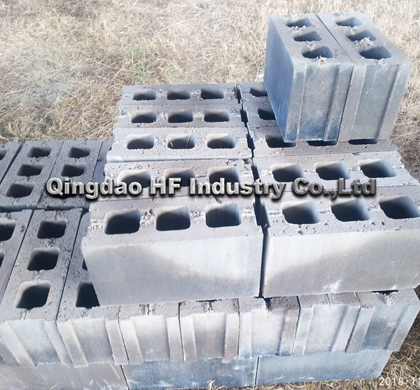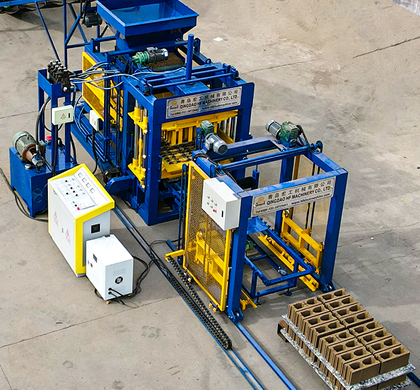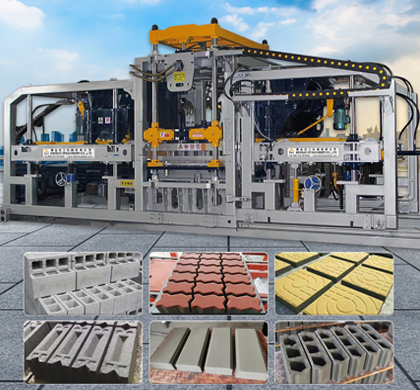The Molding Vibration Block Machine has a short forming cycle and high production output. The continuous increase in vibration frequency during material feeding and forming vibrations reduces the feeding time by 3 to 4 seconds. The table vibration machine accelerates at about 5-8g with a vibration forming time of 3-5 seconds, while the molding vibration machine accelerates at about 9-10g with a vibration forming time of 1-3 seconds. This allows the mixed material to quickly liquefy and de-air, with a short wait time for residual vibration to dissipate. The entire block production cycle is shortened by 5 to 7 seconds. Using the same materials within the same timeframe, greater customer benefits are achieved.

High Density of Products: Blocks produced by the molding vibration block machine have high density and consistent brick density. For non-load-bearing walls, the compressive strength ranges from MU7.5 (below 7.5 MPa) to MU3.5 (above 3.5 MPa). For load-bearing walls, the compressive strength ranges from MU10 (above 10 MPa) to MU20 (20 MPa). The higher the strength grade of cement blocks, the higher the hardness, lower the porosity, and the greater the compressive strength. Molding vibration machines are preferred due to their high vibration power and effective compaction during block production.

Superior Appearance Quality: Products made with table vibration machines have height deviations. For hollow bricks produced by molding vibration machines with heights ranging from 190mm to 200mm, the height deviation is between 1-1.5mm, whereas for table vibration machines, the height deviation is between 2-2.5mm. Molding vibration machines produce more standardized products. Due to high vibration frequency and amplitude during molding, slurry rises quickly, resulting in a smooth and aesthetically pleasing brick surface.

Design Advantages: Hollow bricks are formed by mold cores occupying internal spaces of the products. Mold cores must be connected by cross beams for positioning. These beams obstruct the path of raw materials into the mold during production, leading to under-pressed areas in hollow bricks, significantly reducing overall product strength and causing defects like vertical cracks. Molding vibration machines feature a floating crossbeam design that alleviates feeding obstructions and eliminates crossbeam imprints on bricks after demolding.

Low Failure Rate and Easy Maintenance: The overall design layout of the molding vibration block machine is reasonable with a low failure rate, making it easy and quick to maintain and repair. Faults are easily detected and resolved during operation.

Efficient Material Feeding: During operation, the molding vibration block machine’s high vibration frequency and amplitude result in fast material discharge. The slightly wetter concrete mix results in more effective and faster material feeding compared to table vibration machines. Bricks are uniform throughout, avoiding issues like uneven density.

Reduced Noise: Molding vibration block machines produce 20 to 25 decibels less noise than equivalent table vibration machines. For instance, table vibration equipment typically measures 95-105 decibels, while molding vibration equipment measures 80-90 decibels, proving the noise reduction advantage of molding vibration machines.

Stable Operation and Precision: During on-site inspections, molding vibration block machines demonstrate stable operation with higher product density and dimensional accuracy compared to other equipment. The hydraulic and electrical control systems run smoothly, with braking units significantly reducing residual vibration time. Qualified bricks are consistently produced without manual intervention, achieving an unmanned operational mode. The stacking machine is also well-designed, capable of running four boards at four levels simultaneously, saving time on frequent brick placement. In production sites, nearly no defective bricks are found, and the product yield rate is high. Thin-walled blocks produced by table vibration machines cannot be stacked more than three layers, whereas molding vibration machines can stack four layers, proving the higher density and compressive strength of the products.

Brick manufacturing has been an essential part of construction for centuries, providing durable and aesthetically pleasing building materials. However, the process of producing bricks is not without its challenges. As the world becomes more environmentall

A hollow block machine is a piece of industrial equipment specifically designed to produce hollow blocks, which are a type of concrete masonry unit (CMU) used in construction. These machines come in various sizes and capacities, and their primary function

Concrete blocks are fundamental components in modern construction, providing the essential material for building walls, foundations, and various structures. The production of these blocks requires specialized machinery designed to mix, mold, and cure the

Whether for inquiries for inspections and
maintenance, for individual plant optimizations or
extensions, or spare and wear parts.

Our after-sales service is at your disposal for all
questions

Gemini Tower, Block B, Chunyang Road, Chengyang District, Qingdao, China
Show on the Map
We will contact you within 24 hours.